The SU carburetor
and no, it’s not only setting the fueling screw right… the order of arrangement in
“The full history of Cabriolet Mini’s”

Note: this article isn’t finished and we’re developing it on the go! nevertheless feel free to gather your relevant information already.
Introduction
Another article I am looking for is from the French Magazine “British Cars” from July/August 1994. In it (and now I quote):
“Cabrioni’s convertible with manually operated top tested the best compared to the original Rover Mini convertible and a German Mini convertible from the SSC brand.
“British Cars” called the Dutch product ‘sans contestes le plus craquant’. In other words: Cabrioni leaves the competition behind.”
Timeline
1962 – Crayford converted a 1959 Mini into a cabriolet – AFO 887 – England
1965 – Donald Healey converted an Austin Seven from 1959 with chassis 102 (!) to a Cabriolet – 627 HU – England
1974 – Dierk Mengers ‘Cabrio 1’ and a DIY Cabrio Mini – Germany
1984 – MASSA – Mini Vollcabrio and Mayfair Cabrio from L&H – Germany
1989 – Cabrioni Cabrio Design Mini’s – Holland
England 1962
The 1st Mini MK1 Cabriolet – The Crayford Mini

The world’s first Mini convertible was the brainchild of David McMullan (sales), manager of Sales at Lambretta Trojan of Croydon, and Jeffrey Smith (Engineering and design). The two men formed a lifelong friendship and partnership, united by their vision to transform the innovative new Mini into a convertible. In 1962, new Minis were still hard to come by, so David and Jeffrey could only afford a three-year-old 1959 model for their experiment. This car, registered as AFO 887, was worked on during late-night hours since both men needed to keep their day jobs at Lambretta to make ends meet.
Their days were filled with work at Lambretta, followed by nights spent laboring on the Mini in a lock-up in Stroud, Kent. Despite their busy schedule, David found time to visit his wife, who was in the hospital expecting their first child. On several occasions, David was reprimanded by the hospital staff for bringing oily hands and Mini parts into his wife’s room.
In August 1962, David’s first son, Sean, was born. Just minutes after the birth, David and Jeffrey headed to Stroud, where they drove their other “baby,” the now-converted AFO 887, on the road for the first time as a convertible.
David and Jeffrey eventually left Lambretta Trojan and founded Crayford with a joint investment of £20 and a toolbox each. Their first Mini convertible, painted light blue, was unveiled to the national press on June 3rd in the Daily Mail’s motoring section. The launch was a success, quickly attracting a network of dealers who began taking orders. The price was set at £690 for a new car, or £129 to convert a used one.
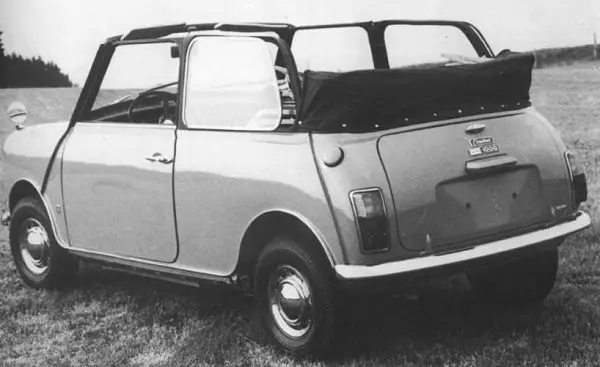
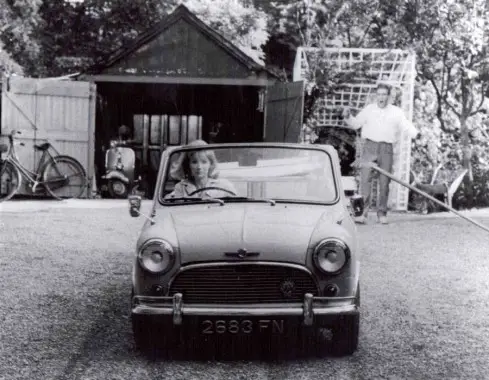


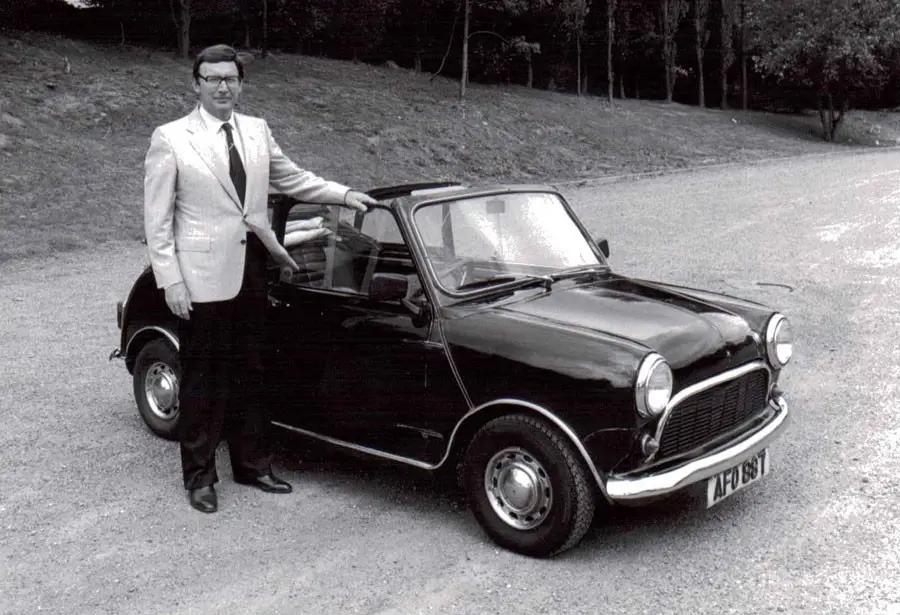
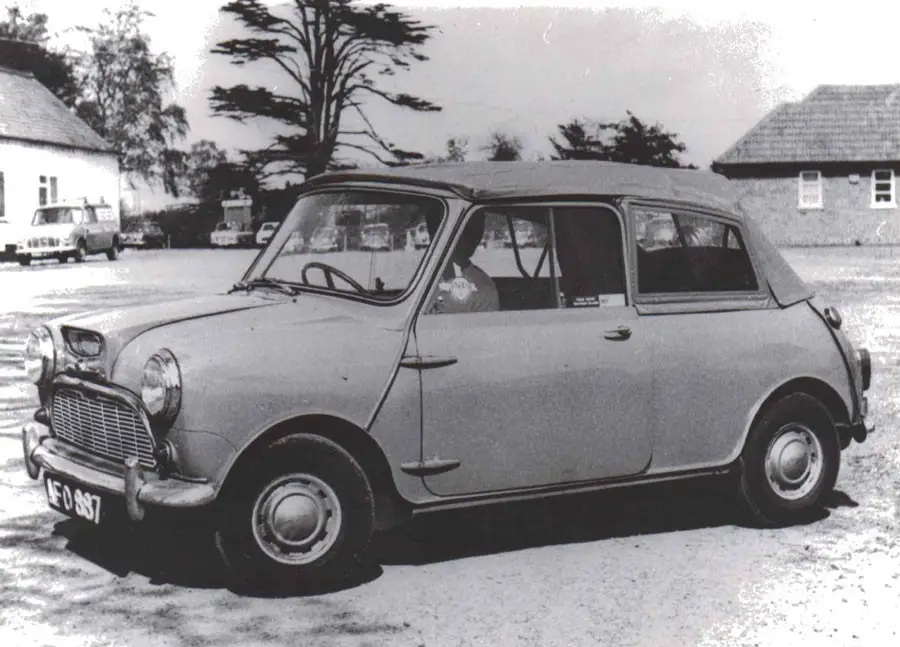
An early breakthrough for Crayford came when MGM featured the new Crayford Mini Cooper in the black-and-white movie “Night Must Fall,” starring Susan Hampshire and Albert Finney. Both actors drove the Crayford extensively throughout the film. When the movie was released, David’s wife watched it three times in one afternoon.
Crayford introduced variations based on Austin and Morris cars, and later produced a Clubman convertible. The early Mk.1 cars were completely open, with rear side windows that pulled out like those on a Morgan. They also offered a “sunshine” conversion with fixed sides, and created a one-off open beach car with jeep-like sides for the Managing Director of Bristol Street Motors to use at his villa in Spain.
Today, these early Crayford Minis are extremely rare, with only 15 cars known to exist. Due to high demand, there are also fake versions around, so be cautious of any car with roll bars, hoops, or T-bars.
England 1965
Mini Cabriolet – 2nd Mini EVER build – 627 HUE –
On April 3rd 1959 the first Mini’s were produced by hand in Longbridge. The vehicle with chassis number 101 was followed that day by “number 102”. This car with registration 627 HUE still exist this day.
Mini 627 HUE was build in 1959 and bought over by Donald Healey in 1965. together with the approval of Alec Issigoni (designer of the original Mini), the Mini was converted into a “two-seater” convertible which Alec also used for his own personal transport for a while. So the first Mini Cabriolet was the second Mini to be ever build! Today 627 HUE, along with other historic Mini’s, are in hands of Mr. Maruyama’s collection in Japan.
Austin Mini serial number 101 is considered destroyed, number 103 with registration KEG 77 still exist.
more about the first Mini’s ever build here.
Germany 1974
Dierk Mengers Cabrio mini
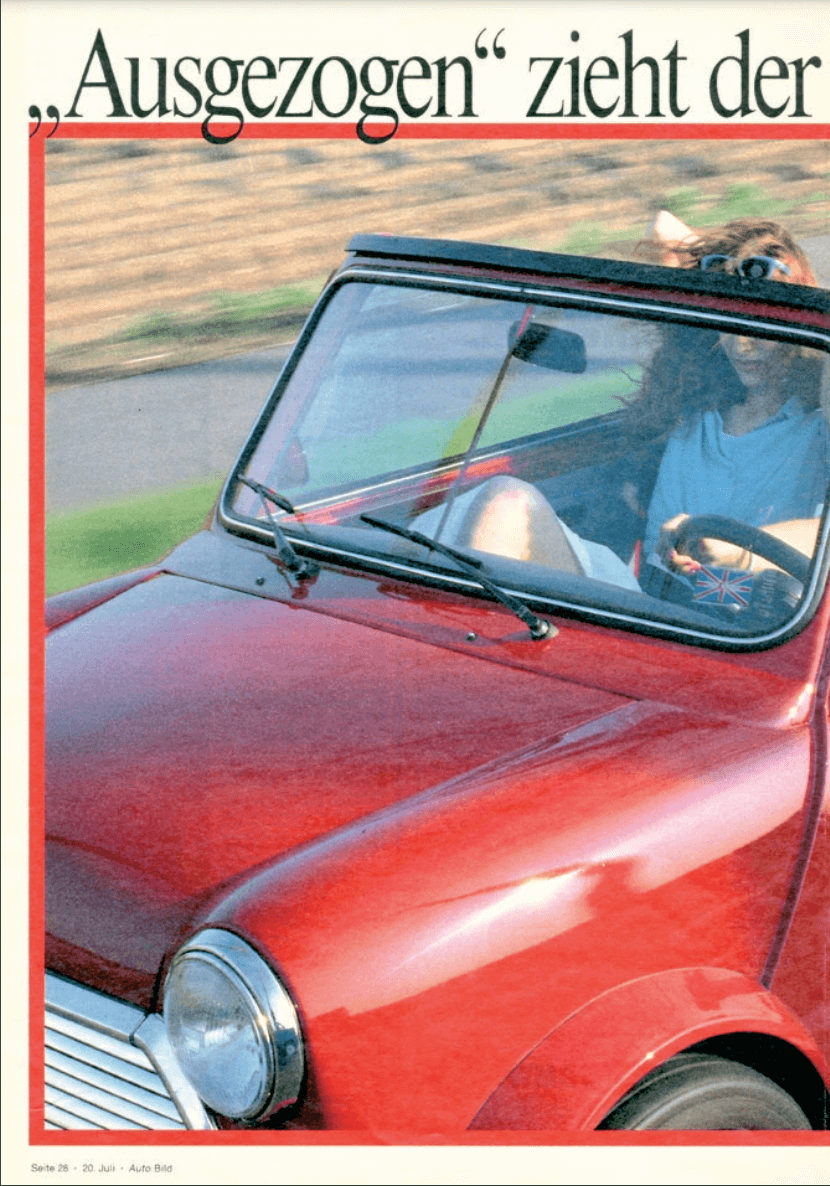
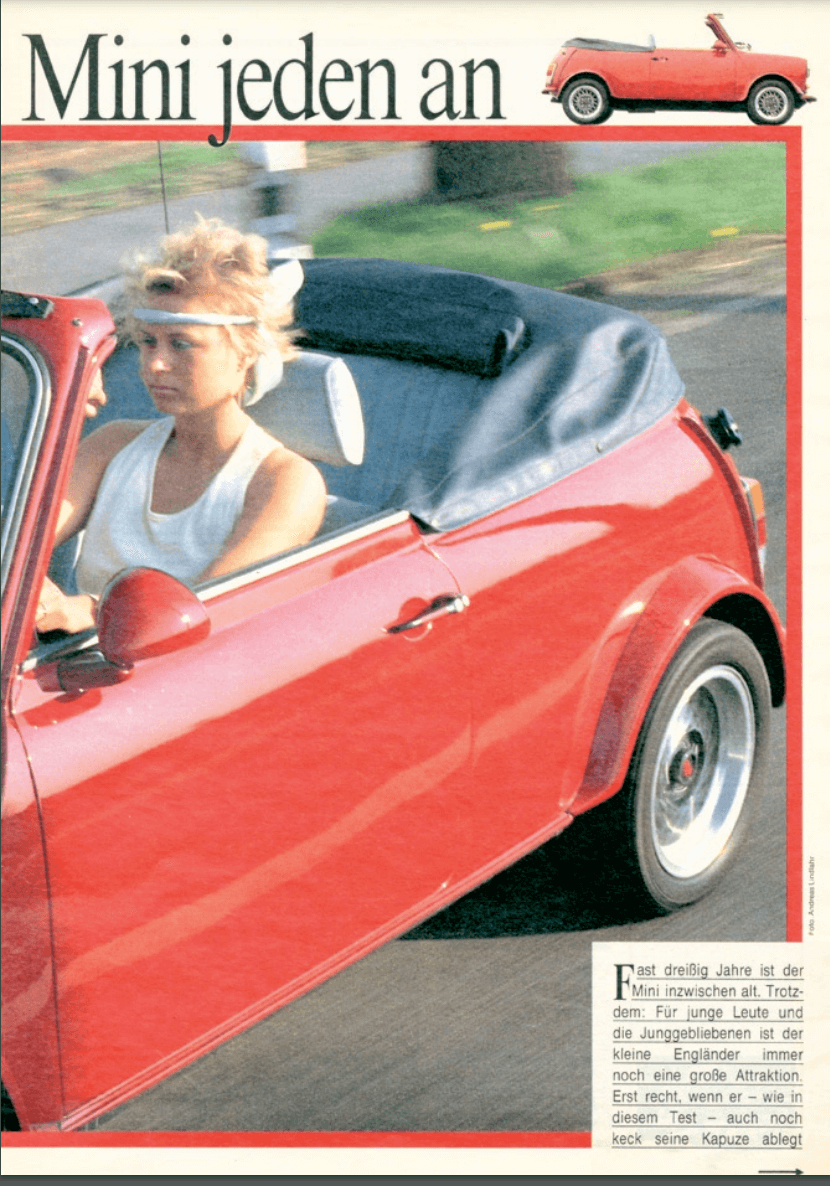
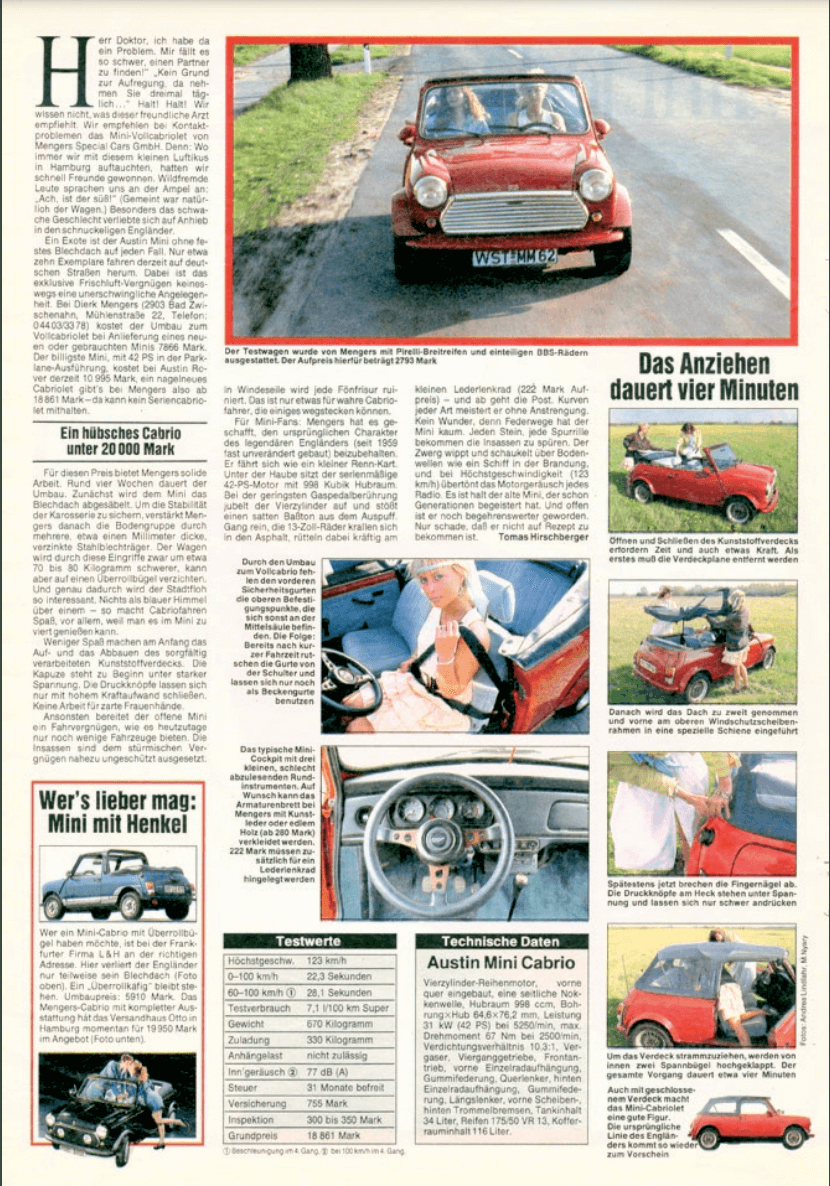
MENGERS, a company based in Oldenburg, Germany, has a remarkable history in custom car building. Their journey began with the introduction of the Mengers Mini Cabriolet in 1974. This model marked the start of Mengers’ own production line, with these small sun worshippers being continuously manufactured and developed ever since. The popular silhouette of the classic MINI is fully preserved when closed, and when opened, the top sits discreetly against the body. The rear and side windows are closely based on the standard dimensions, and thanks to a high-strength modification of the body, important safety parameters have been improved.
Dierk Mengers, the founder, remains actively involved in the company to this day. Under his leadership, MENGERS continues to innovate, developing new custom-built Minis, including enhanced versions of the original cabriolet Minis. The company’s commitment to quality and innovation has made it a standout in the automotive customization industry, seamlessly blending classic designs with modern enhancements.
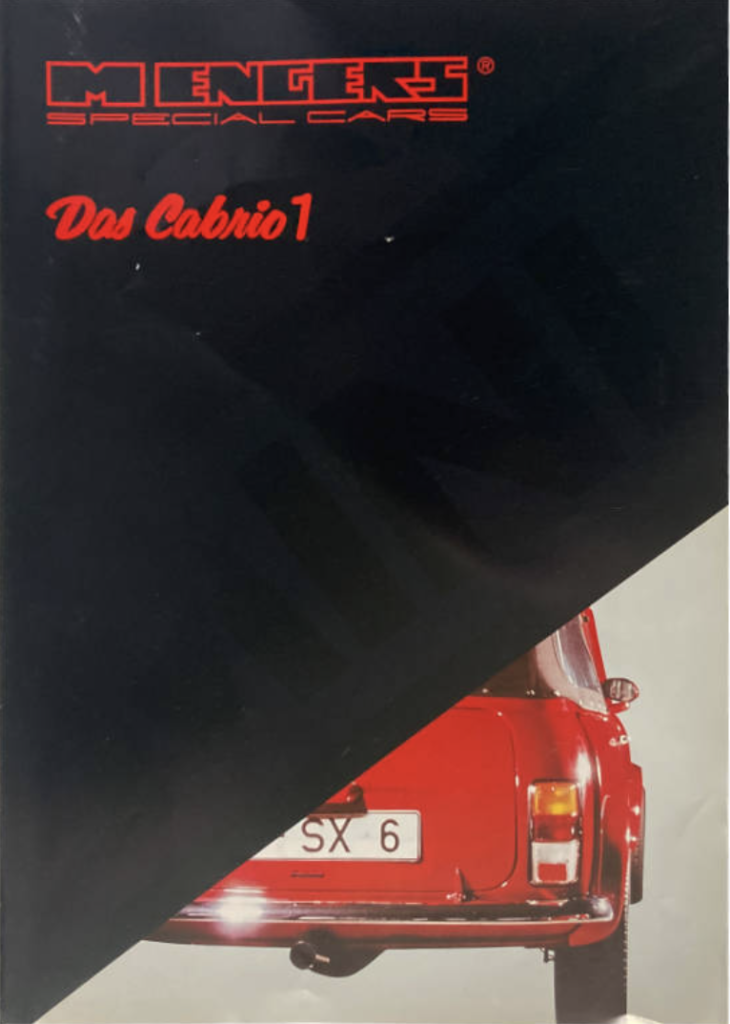
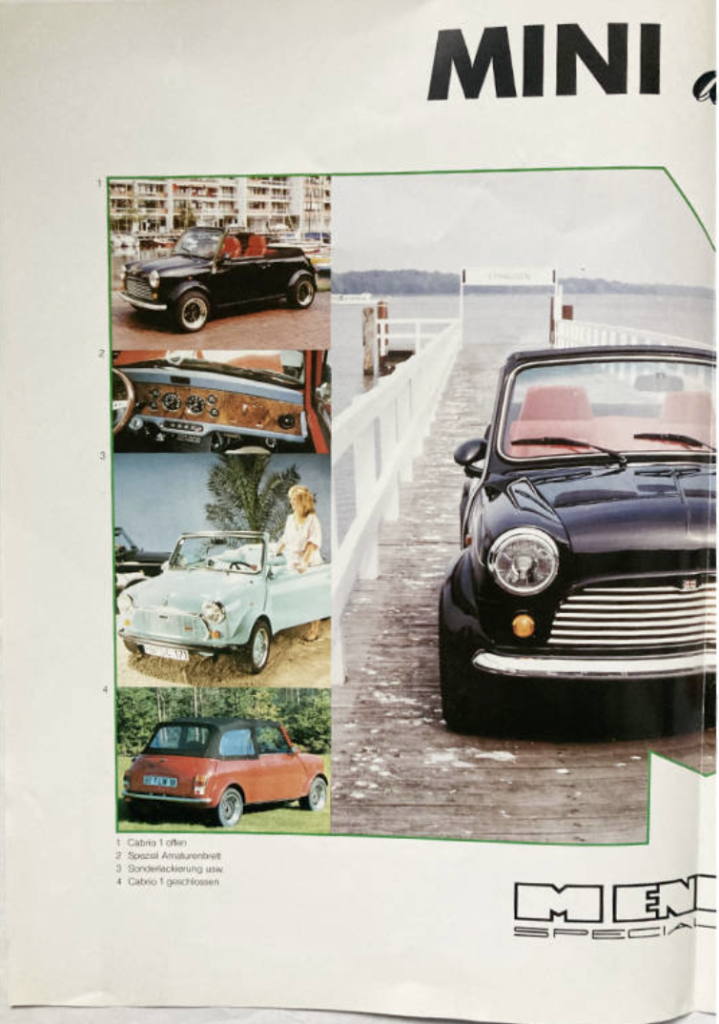
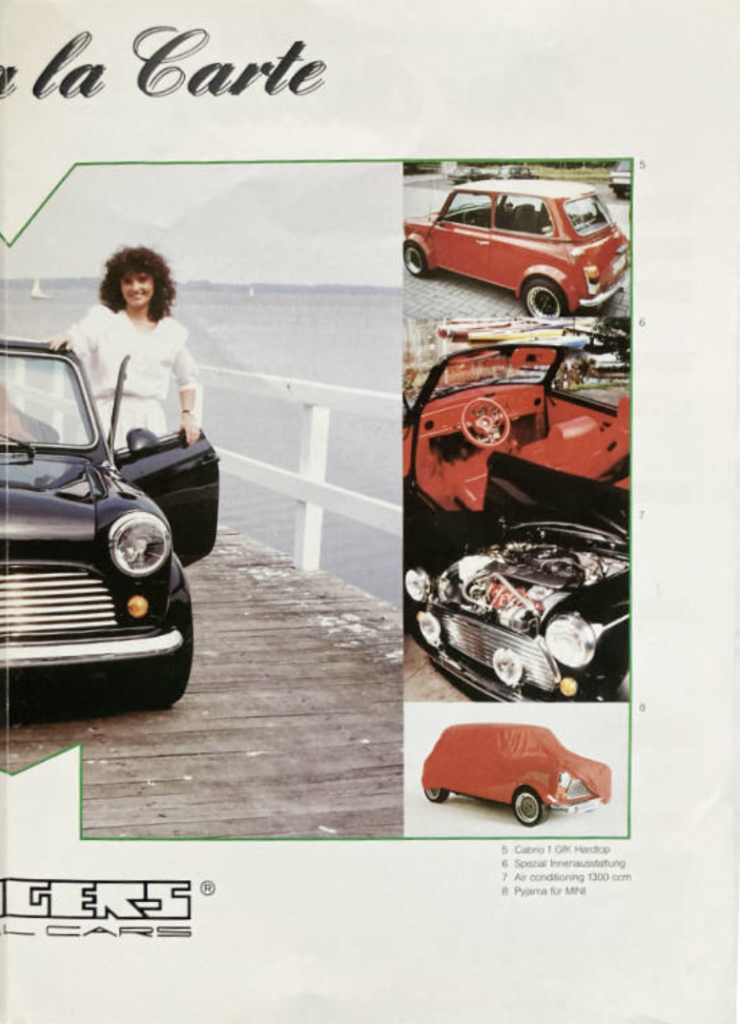
The Cabrio conversion by MENGERS could be ordered in two distinct versions: ‘Das Cabrio 1’ or ‘Cabrio II’. ‘Das Cabrio 1’ offered a fully custom-built Cabrio Mini Classic, meticulously crafted to the customer’s specifications. Alternatively, ‘Cabrio II’ provided a DIY kit, allowing enthusiasts to assemble their own Cabrio Mini Classic at home.
For more information on the cabriolet or other conversions by Dierk Mengers, please visit his website: mini-MENGERS.de/cabrio

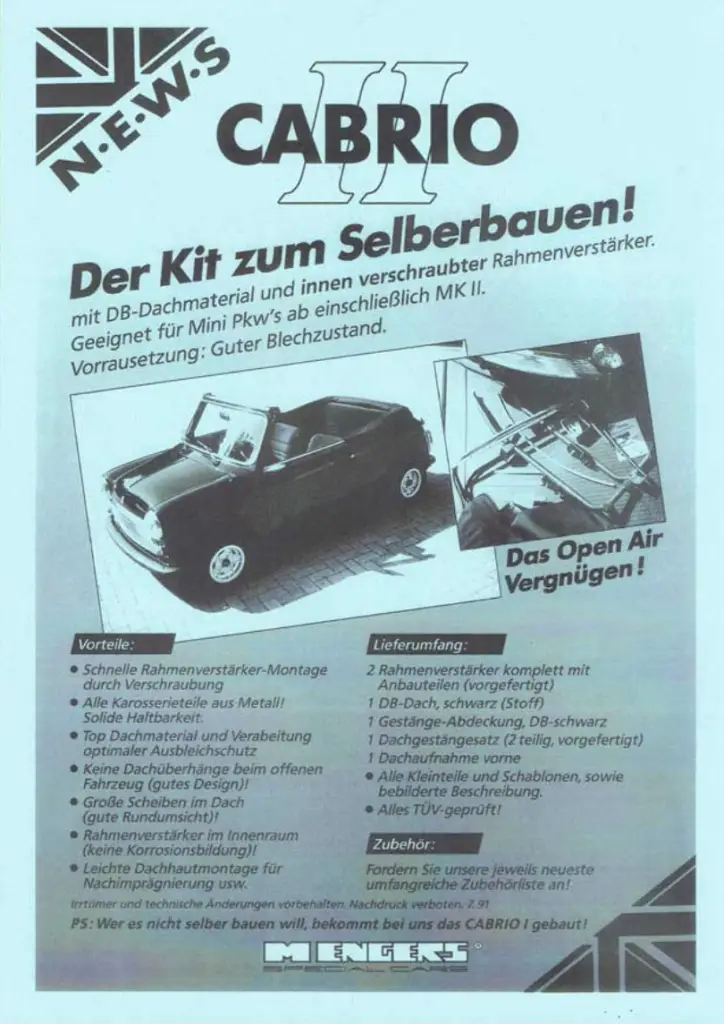
Germany 1984
Sold through MASSA: Leiningen & Hammel (L&H) Cabriolet Mini

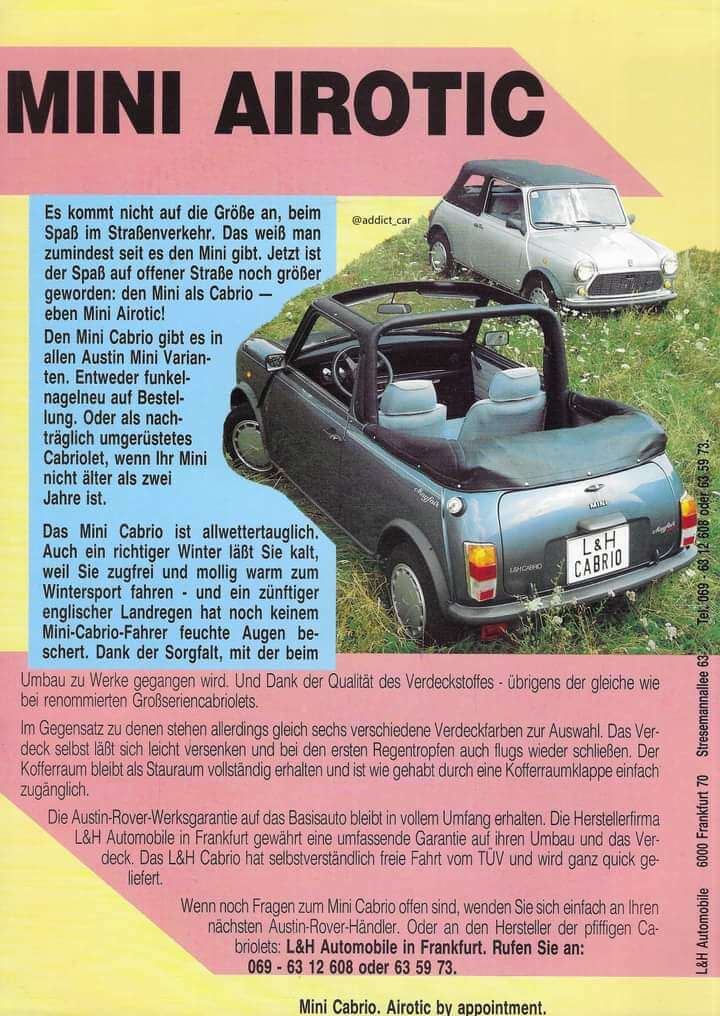
After the 70’s a lot of the German market for Rover cars and mainly the Mini Classic shifted towards Renault or Fiat thanks to their better and bigger dealerships. To change this Austin Rover started a partnership with MASSA, a kind of superstore for all kinds of cars under one roof. The collaboration gave the Germans a lot of creative renamings and special editions, as well as massive discounts and leasing options!
The venture with MASSA included various exclusive offerings, such as cabriolet conversions of the Mini and the Metro, all built by Leiningen & Hammel (L&H). The Mini, equipped with a metal bar behind the front seats, was called the ‘Airotic’, while the full cabriolet version was named the ‘Cabrio’. These cars, delivered through the dealers, came with the standard guarantee.
L&H offered six different colors for the roof and ensured quick delivery of your ‘custom-made’ Mini. The most cars were brand new and ordered directly from the dealer with an option to convert your own Mini Classic if it was no older as two years.. The most converted Mini for L&H was the Mini Mayfair with an 998cc engine and roll bar.
Holland 1988
SSC cabrio Mini 1988

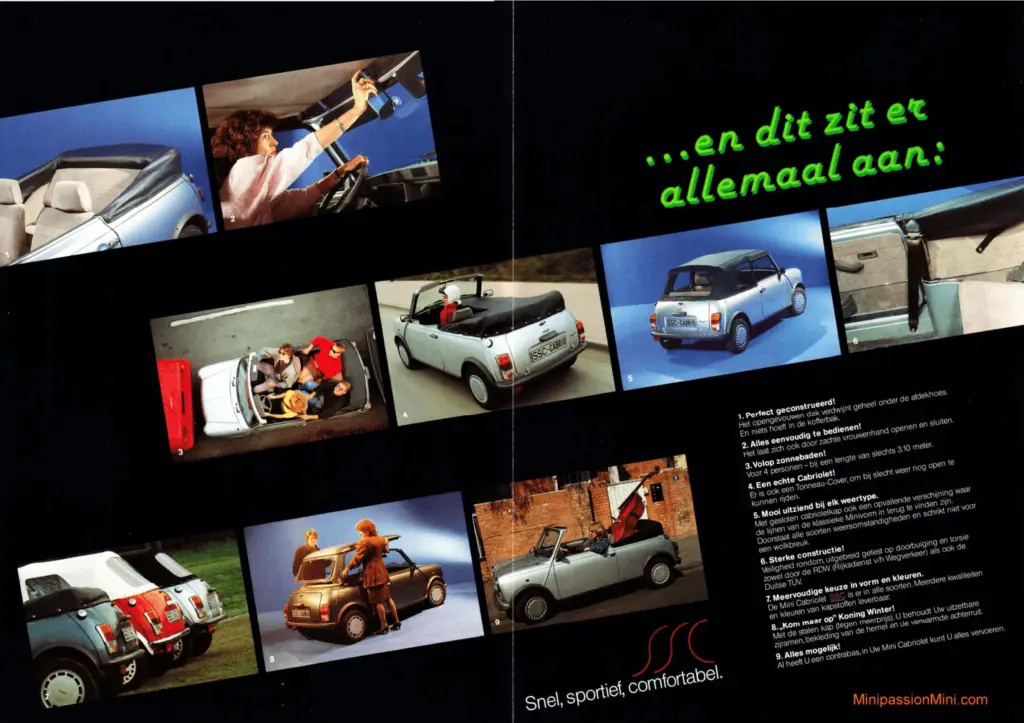

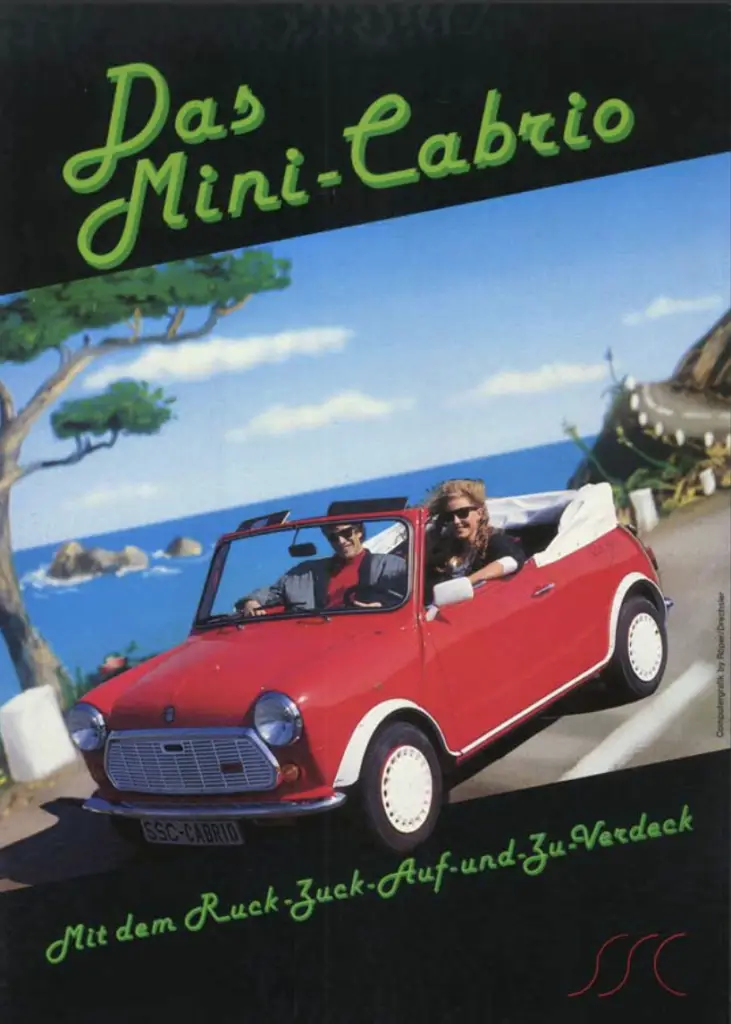
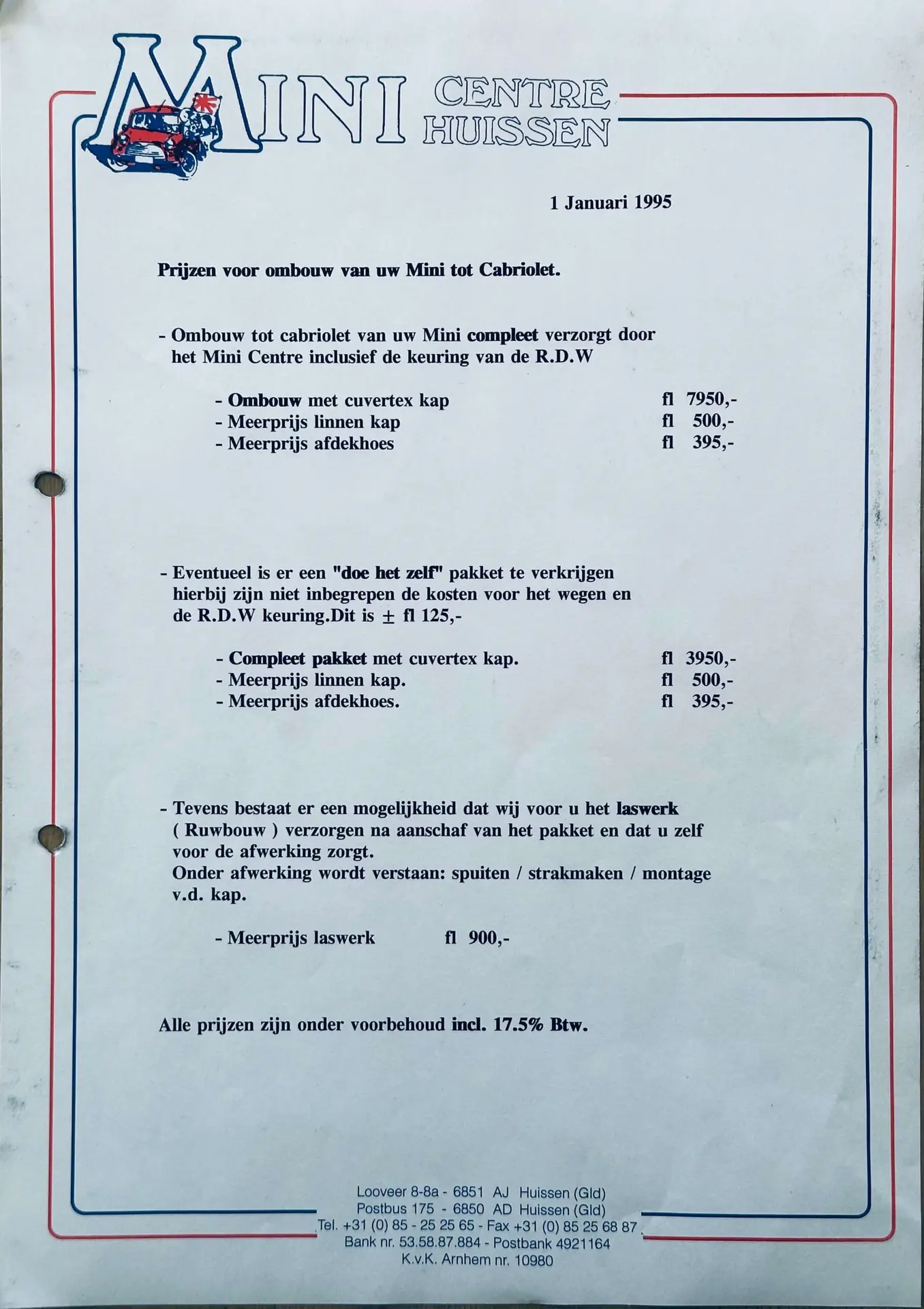
Mini Center Huissen, a Dutch company led by Rob Smits, was well-known for creating about 250 Convertible Minis over the years. These transformations were made possible by Convertible conversion kits obtained from the German company SSC, resulting in similar features among their creations.
Initially, Rob Smits’ main focus was on the conversion process itself, often keeping the standard exterior and interior appearances while adding the convertible roof. This approach ensured that the essence of the Mini stayed true while providing the excitement of driving with the top down.
However, the situation shifted with the emergence of Cabrioni Convertible Design, also situated in Huissen. Cabrioni’s conversions were distinguished by their luxurious details, making them stand out from Mini Center Huissen’s offerings. Interestingly, the founders of both companies, Rob Smits and Ed van Bon, were not on good terms at the time.
Regarding the eventual destiny of Mini Center Huissen and its Convertible Minis, information is limited. It’s believed that around 2005, the company halted its conversion activities. This decision likely resulted from the withdrawal of approvals for convertible cars, making the process economically impractical due to the high expenses involved in obtaining new approvals. Consequently, this situation led to the discontinuation of their convertible building kits.
Holland 1989
Cabrioni Cabrio Design in Huissen, Netherlands
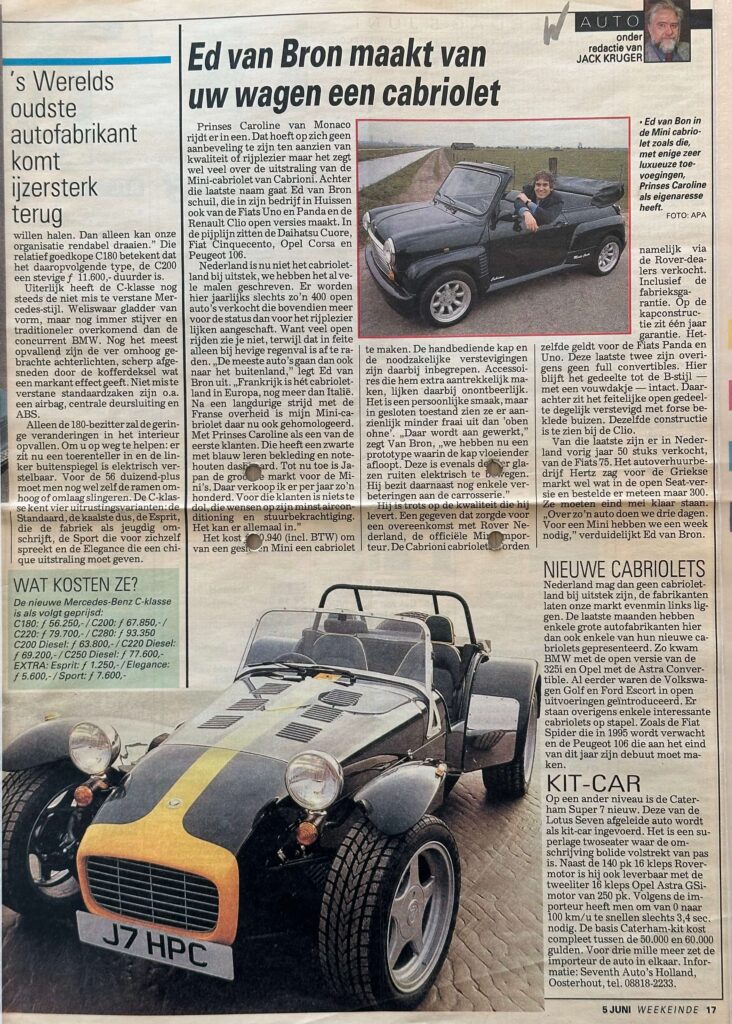
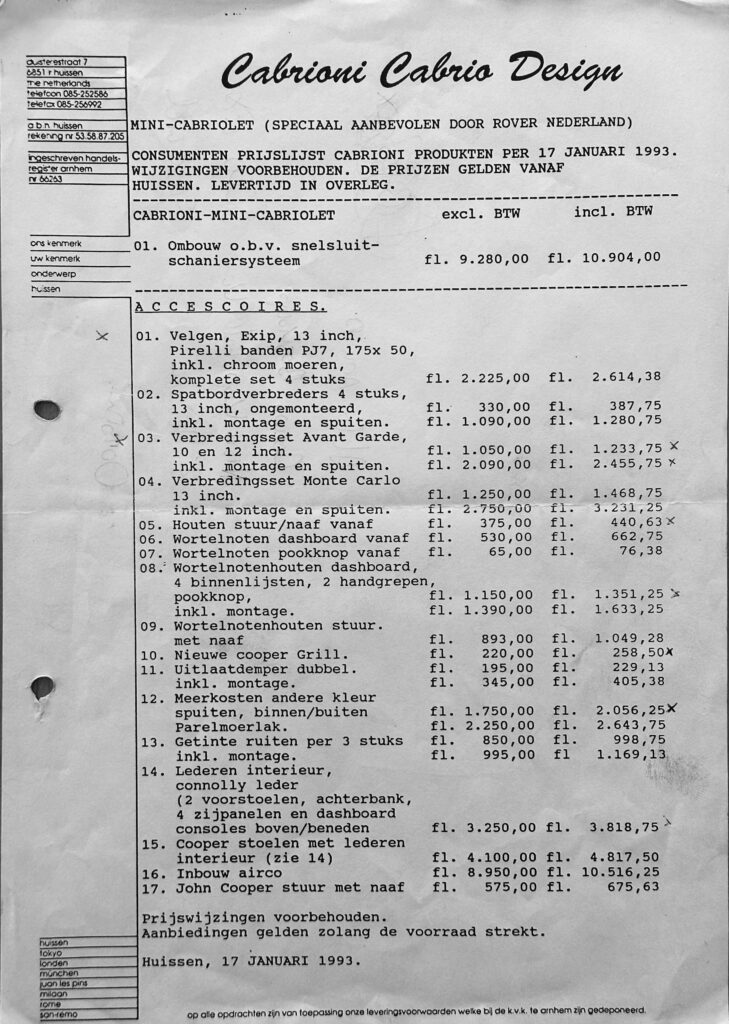
Princess Caroline of Monaco drives one. While this doesn’t necessarily guarantee quality or driving pleasure, it does speak volumes about its appearance. Cabrioni Cabrio-Design, founded on April 17, 1989, in Huissen by Ed van Bon and Hans Veldkamp, operated until 1995. The company began in the body shop of Veenhuis garage in Huissen, where the first convertibles were made. Due to growing interest, Ed quickly opened his own garage to focus on convertible Minis.
‘Rolls Royce of cabrio Mini classics’
Cabrioni became known as the Rolls Royce of cabrio Mini classics, featuring luxurious interiors with wood accents, high-quality speakers, and stylish seating. The roofs indeed looked similar to those of another German company, L&H, but the rest of the car’s design was significantly different.
Cabrioni was famous for its three body kits: Avant Garde, Avenue, and Monte Carlo. These were designed by Werner Waldecker, a German with connections in the Czech Republic, where he oversaw the production of the moulds.
‘sans contestes le plus craquant,’
Cabrioni received high praise in the French magazine “British Cars” in July/August 1994. The magazine tested Cabrioni’s manually operated convertible top against the original Rover Mini convertible and a German Mini convertible from SSC. The review stated, “Cabrioni’s convertible with manually operated top tested the best compared to the original Rover Mini convertible and a German Mini convertible from the SSC brand. ‘British Cars’ called the Dutch product ‘sans contestes le plus craquant,'” meaning Cabrioni was the best.
Although the company closed, Cabrioni Cabrio-Design remains a significant part of automotive history, especially for convertible Mini cars. The founders and their unique designs are still remembered by car enthusiasts and collectors.
Lamm Cabrio Mini Classic 1990, Germany
In July 1993, Rover launched the Mini as a factory convertible. It was based on the ‘conversion convertible’ from the German Rover car dealer Lamm.
The “Lamm-Cabrio” was a “redesigned” Mini Mayfair with a 1275 cc engine, which was released in 1991 in a limited “edition” of 75 copies (a subsequent delivery of approximately 25 pieces followed) in the color “cherry red” . Red) was sold with a “styling kit”. The noble interior of the ‘youthful sheep’ also included a ‘Clarion stereo system’.
Rover mini Cabrio 1992
Based on the German model (an exact copy was not possible because Lamm did not want to give up the “rights”), the “factory Rover” received a color-coordinated “body kit” including fender flares, a front spoiler, side skirts and a rear bumper included. In keeping with the ‘refined bodywork’, the vehicle rolled off the assembly line on 12-inch Revolution alloy wheels with 165/60 tires. The bodywork was extensively stiffened as follows: extra cross beam under the front seats, extra sheet metal under the rear seats, parallel sill reinforcements and reinforcements on the B-pillar. The interior was very elegantly designed: the most beautiful carpet, wood paneling and Recaro sports seats. The manual canopy could be quickly lowered and safely anchored with “clips” at the front and back.
The 1275 cc engine with 63 hp was equipped with single point fuel injection (SPI) with a controlled catalytic converter. With an empty weight of 711 kg, the “Rover” reached a top speed of 148 km/h. The distance from “zero to one hundred” was covered in 13 seconds.
The convertible was initially available in two colors: Caribbean Blue and Nightfire Red. In 1994 the ‘open’ Mini was also delivered in Racing British Green. However, the ‘factory convertible’ was not built directly by Rover, but by an English ‘subcontractor’. Due to the high price of over DM 30,000, only 2,800 pieces could be supplied to women/men in 1996.
and no, it’s not only setting the fueling screw right… the order of arrangement in

This table provides detailed specifications to identify various Mini accelaration performance, including what kind of
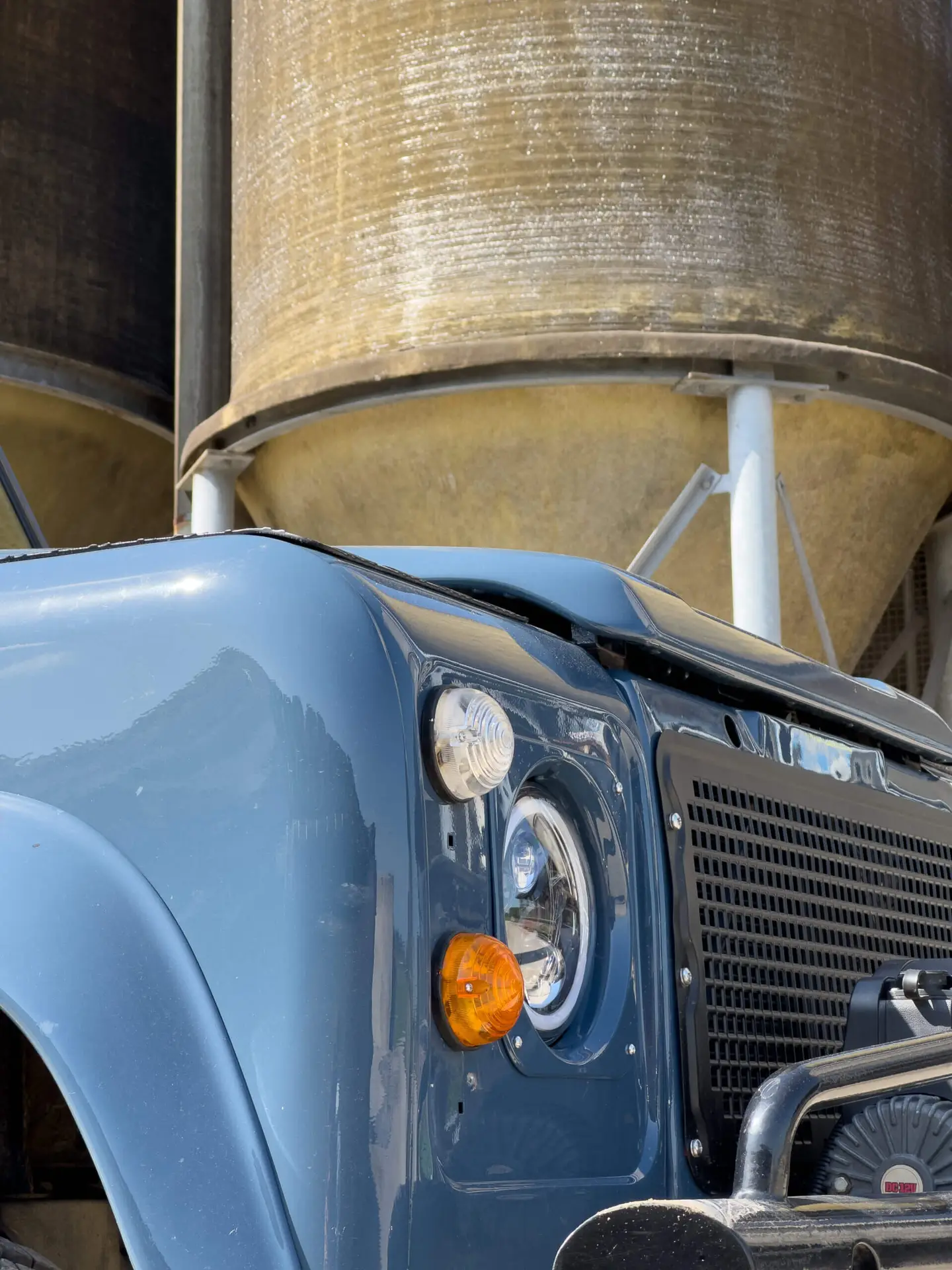
Welcome to this guide on the 2.8 GTV engine parts. While many parts are shared
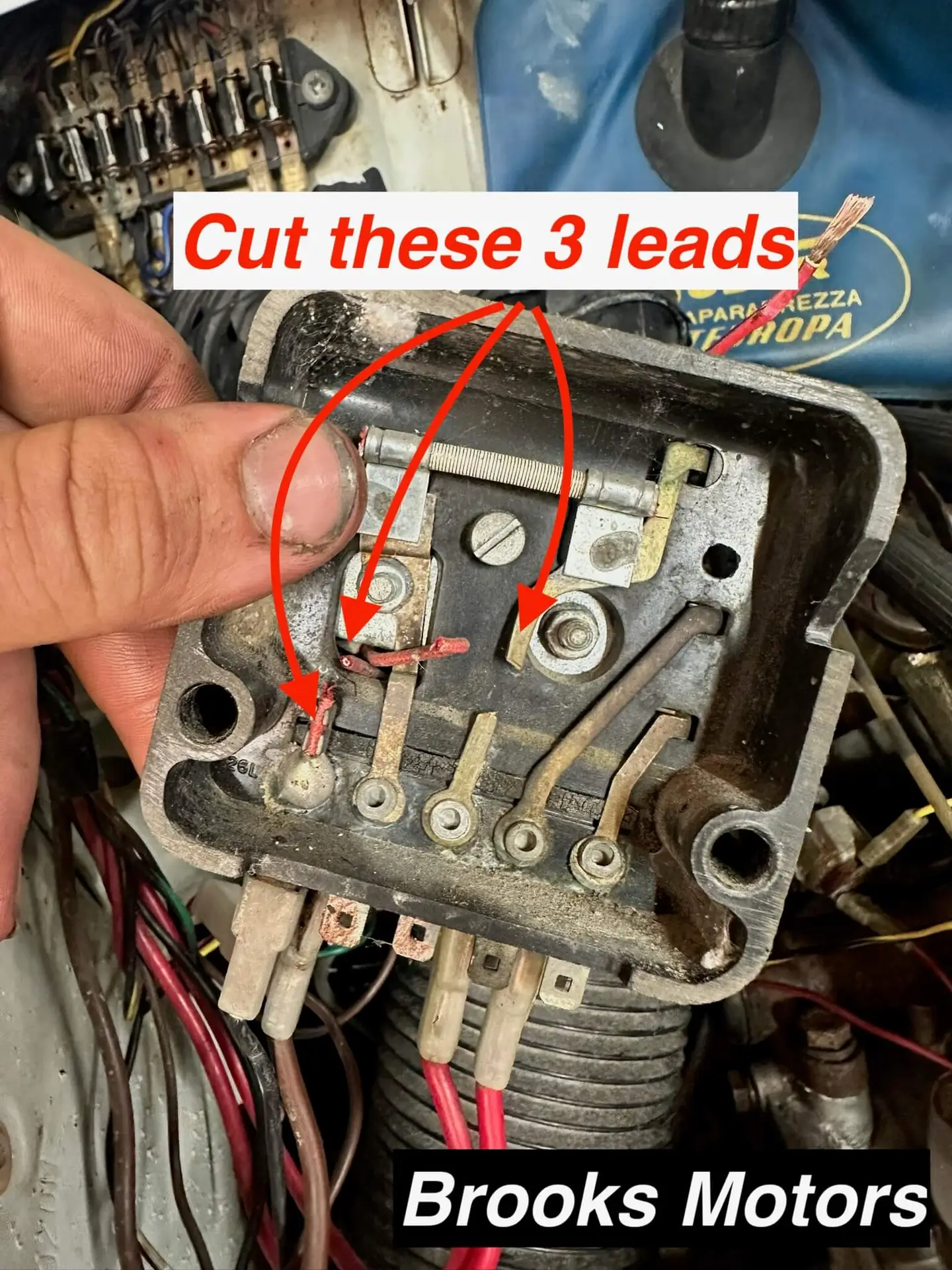
Converting a Lucas RB106 Voltage Regulator to an Alternator Dummy Box The Lucas RB106 control
00 316 38 37 66 91
[email protected]
Broekseweg 100, 4231VH
Meerkerk, The Netherlands
KvK: NL81356773
BTW: NL862055489B01